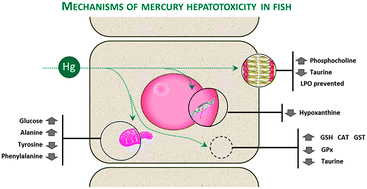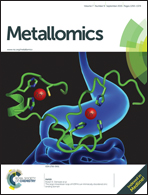Unravelling the mechanisms of mercury hepatotoxicity in wild fish (Liza aurata) through a triad approach: bioaccumulation, metabolomic profiles and oxidative stress
Abstract
Clarification of the mechanisms of mercury (Hg) toxicity in fish remains challenging. An innovative approach to this clarification is the combined assessment of metabolomic shifts, alterations in the antioxidant system and the risk of oxidative damage, and Hg bioaccumulation. This strategy was applied to the livers of golden grey mullet (Liza aurata) inhabiting an Hg-contaminated system in Aveiro Lagoon, Portugal. Marked changes in both the metabolic profile and the response to antioxidants were observed in fish exposed to Hg in the environment, indicating their compromised state of health. The metabolomics analysis showed a clear differentiation between the contaminated and uncontaminated areas, revealing that Hg has multiple levels of impact, including membrane stabilization/degradation/repair processes, osmoregulation, energy metabolism, gene expression and antioxidant protection. Research on oxidative stress biomarkers showed that Hg triggered adaptive responses in the antioxidant system as seen by an increase in the activities of glutathione-S-transferase and catalase, as well as the total glutathione content, which compensated for a decrease in glutathione peroxidase activity. The integration of metabolomics and oxidative stress endpoints allowed the identification of reduced glutathione as a first line of defence against Hg and evidenced oxidative insults in cell membranes, recognized through the increase in phosphatidylcholine degradation products (phosphocholine and glycerophosphocholine). Despite these effects, the induction of lipid peroxidation was efficiently prevented. The triad approach used here was demonstrated to be sensitive and effective towards a mechanistically based assessment of Hg hepatotoxicity in fish.

- This article is part of the themed collection: Metals in marine biochemistry


 Please wait while we load your content...
Please wait while we load your content...